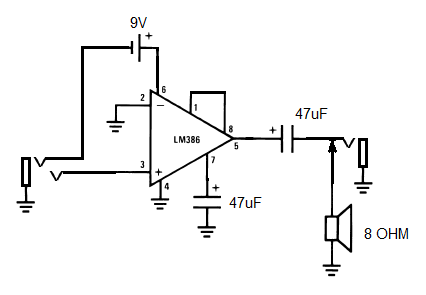
The Smoke Bomb
July 4, 2013.
There are lots of references on the Web to Bruce Zinky's Smokey amp. This is a very simple guitar amp using an LM386 power amp chip and a 2" speaker, designed to fit in a cigarette pack. It has no controls - you plug the guitar in to turn it on. You can drive bigger speakers with it or even use it as a fuzz box. (By the way, driving bigger speakers does not drain the battery quicker, as some posters on various forums seem to think.) Power output is claimed to be 1 Watt.
If you have seen the regenerative receivers on this site, you know that I like minimalist circuits, so I just had to try the circuit:

Just one chip and two capacitors! Pretty clever. One unusual thing about the design is that pins 1 and 8 are shorted, instead of being bridged with a 10uF capacitor as the datasheet for the part recommends. Apparently that works. The other divergence from the datasheet is the lack of an RC network at the output, there to help stabilize the amplifier (keep it from oscillating).
I found some LM386's in my stuff so I slapped the circuit together. There weren't any 47uF capacitors in the junk box, so I used a 22uF for the pin 7 bypass, and 100uF for the output coupling. For testing, the output drove a 4", 4 Ohm Motorola communications speaker. The amp worked, sorta, but on the scope it showed small spurious oscillations at one peak of each cycle, which resulted in a spitty kind of distortion that was not very musical. Changing to an 8 Ohm speaker just moved the fuzz from the top peak to the bottom peak. The fuzz occurred well below the clipping level, so there was really not much clean headroom.
Now, there is more to a design than just the schematic, and it may be that the commercially sold Smokey amps are unconditionally stable. Maybe those capacitor values are "magic", or maybe the layout helps stabilize the amp. Maybe the designer thought that the spitty distortion was cool.
Anyway, I messed around with it on the bench until it was stable with any load I could throw at it. The spits went away and the sound of the amp into the test speaker showed promise. The RC network at the output and the bypass cap at pin 6, close to the chip, were both necessary for stability. The bypass at pin 7 didn't seem to do much. The final result has one more resistor and capacitor than Zinky's circuit, but it's still pretty simple, and it retains most of the clever bits:

My father-in-law died 15 years ago, leaving us his garage which contained a Radio Shack 3 1/2" "full-range" replacement speaker, new in the box. I thought about throwing it away a few times. Imagine the joy of finally finding a use for it! I like to build ham radio circuits in tin boxes, which are easy to solder to and easy to put holes in. It took a little to get the tin box not to be so rattle-y, but the speaker fit in the lid and it sounds pretty good. The box is about 4 1/2" x 4 1/2" by 2 3/4", so it's a handy size but a lot bigger than a Smokey. The battery holder is a piece of tin that came from the hole cut in the lid for the speaker. Hand wired point to point - it should sound pretty good!
I tried to dress it up a little, but the workmanship is on the crude side. It looks better in the picture than in person, but it's still cute.
The resulting amp is pretty useful and pretty musical. There's enough clean headroom for use as a practice amp, at least in some situations. Breakup is nice and fat and it's fun to play. It fits in the pocket of gig bags. The battery lasts a long time. I've made small amps out of transistor radios before but I found that the 2" speaker size, as used in the Smokey amp, just isn't very useful. It's mostly all buzz and not any clean to speak of. (I also have run a 40W Bassman head into one of these 2" speakers for effect, but that's another story.) This 3 1/2" speaker in a larger box is different. I also used to have a Pignose, which I did not play very much. I think I just didn't like the way it sounded. This amp, while not quite as loud, is much more inviting.
When driving the 12" speaker in a Fender Hot Rod Deluxe cabinet it gets loud enough to bug the neighbors. It's a little dark sounding because the input impedance is only about 50K Ohms, but not bad. It works pretty good as a fuzz box, though you have to turn the amp you are feeding it to way down. I plugged it into the low sensitivity jacks on the amps I tried it with.
Since the guitar and cord provide audio coupling, input bias and part of the power switch, the design is real sensitive to dirty or otherwise bad connections and especially sensitive to dirty plugs. Hey, it's a minimalist design. Try cleaning the plugs on your cord if you have unusual noises or drop-outs. I have had a number of weird sounds come out of the box for these reasons.